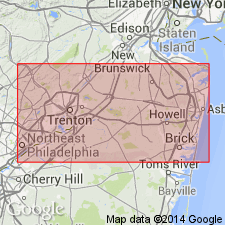
- Usage in publication:
-
- Pensauken formation
- Modifications:
-
- Named
- Dominant lithology:
-
- Gravel
- Sand
- Clay
- Marl
- AAPG geologic province:
-
- Atlantic Coast basin
Summary:
Pensauken formation, named in this report, represents the second stage of the yellow gravel. Consists of gravel, sand, loam, clay, and marl derived from underlying Beacon Hill formation and Cretaceous beds. Thickness 0 to 60+/-ft. Named for exposure at mouth of Pensauken Creek. Unconformably overlies Beacon Hill sand and gravel and unconformably underlies Jamesburg [Cape May] formation. Age is Pleistocene.
Source: GNU records (USGS DDS-6; Reston GNULEX).
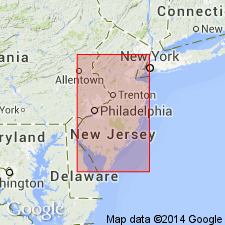
- Usage in publication:
-
- Pensauken formation
- Modifications:
-
- Revised
- AAPG geologic province:
-
- Atlantic Coast basin
Summary:
Bridgeton Formation is introduced for beds underlying Pensauken formation [restricted] and overlying Beacon Hill gravel. Author states that in some places the Bridgeton formation "seems not to be clearly separable from Beacon Hill formation, which preceded, while in others it is not easily distinguishable from Pensauken which follows; but that in other places "it is distinctly separable from the Pensauken and in still others from the Beacon Hill."
Source: GNU records (USGS DDS-6; Reston GNULEX).
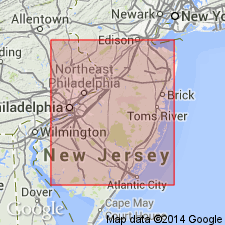
- Usage in publication:
-
- Pensauken formation
- Modifications:
-
- Revised
- AAPG geologic province:
-
- Atlantic Coast basin
Summary:
Bridgetown formation had been included in Pensauken formation of 1895 and earlier reports. Pensauken is unconformably overlain by Cape May formation and unconformably underlain by Bridgeton formation. Classified as middle formation of Columbia group in NJ. It is of nonglacial origin, and considered to be approximately equivalent in age to Jerseyan drift.
Source: GNU records (USGS DDS-6; Reston GNULEX).
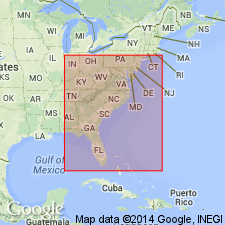
- Usage in publication:
-
- Pensauken formation
- Modifications:
-
- Revised
- AAPG geologic province:
-
- Atlantic Coast basin
Summary:
Correlation chart (Cooke and others, 1943) discussed. Writer does not agree with the combining of Cape May (part) and Pensauken (part) in the Sangamonian interglacial nor with the combining of the Pensauken (part) with the Bridgeton (part) in the Yarmouth interglacial. Evidence indicates that Cape May is of late Pleistocene age, whereas Pensauken is mid-Pleistocene or older. There is no unconformity within the Pensauken nor any field evidence of a hiatus within the Cape May. Lithologically, the Pensauken and Bridgeton are practically inseparable although the latter has been more eroded and occurs at higher elevations. They are regarded as Pensauken-Bridgeton complex of early Pleistocene, probably Nebraskan to Yarmouth.
Source: GNU records (USGS DDS-6; Reston GNULEX).

- Usage in publication:
-
- Pensauken formation
- Modifications:
-
- Areal extent
- AAPG geologic province:
-
- Atlantic Coast basin
Summary:
Pensauken formation mapped in northern DE. Sand and clay on margin of Piedmont, forming terrace deposits at altitudes of less than 180 ft.
Source: GNU records (USGS DDS-6; Reston GNULEX).

- Usage in publication:
-
- Pensauken formation
- Modifications:
-
- Areal extent
- AAPG geologic province:
-
- Atlantic Coast basin
Summary:
Pensauken formation mapped in eastern PA. Age is Illinoian.
Source: GNU records (USGS DDS-6; Reston GNULEX).
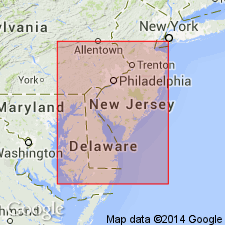
- Usage in publication:
-
- Pensauken Formation*
- Modifications:
-
- Areal extent
- AAPG geologic province:
-
- Atlantic Coast basin
Summary:
In this report, Pensauken is mapped in small part of PA, just south of Trenton NJ. (See figs. 16 and 21.)
Source: GNU records (USGS DDS-6; Reston GNULEX).
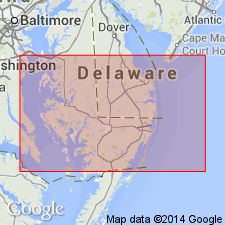
- Usage in publication:
-
- Pensauken Formation*
- Modifications:
-
- Revised
- Age modified
- Areal extent
Summary:
Pensauken Formation is extended into DE and MD. It is no longer included in Columbia Group. Age is changed from early Pleistocene to Miocene.
Source: GNU records (USGS DDS-6; Reston GNULEX).

- Usage in publication:
-
- Pensauken Formation*
- Modifications:
-
- Revised
- Overview
- Areal extent
- AAPG geologic province:
-
- Atlantic Coast basin
Summary:
Name Pensauken Formation is applied to strata in study area formerly mapped as Wicomico. Also includes on the east side of Elk Neck, deposits of gravel that have been mapped as Sunderland. Upper surface of Pensauken forms relatively flat surface of the Eastern Shore part of Cecil Co., east of the Elk River and mostly south of U.S. Rte 40. Surface is at an altitude of about 100 ft along south and east sides of Grays Hill, but decreases gradually to the south. Lower part of the Pensauken is typically a gravel or gravelly sand and is overlain by sand and loam. Thickness of basal gravel varies from a very little to about 10 ft. Thickness of total unit ranges from 15 to 90 ft, but locally may be as much as 120 ft in channels. Unconformably underlies Talbot Formation and unconformably overlies Upland Gravel (new [informal]). Age of the Pensauken is late Miocene.
Source: GNU records (USGS DDS-6; Reston GNULEX).
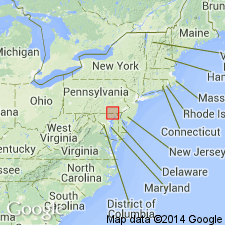
- Usage in publication:
-
- Pensauken Formation
- Modifications:
-
- Age modified
- AAPG geologic province:
-
- Atlantic Coast basin
Summary:
Pensauken Formation (Columbia Formation of the Delaware Geological Survey) petrographically correlated with late Pliocene and early Pleistocene marine deposits. Unit is younger than the informal Perryville formation and older than the informal Turkey Point beds (both named in Pazzaglia, 1993).
Source: GNU records (USGS DDS-6; Reston GNULEX).
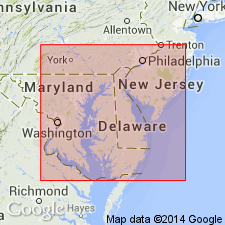
- Usage in publication:
-
- Pensauken Formation
- Modifications:
-
- Overview
- AAPG geologic province:
-
- Atlantic Coast basin
Summary:
Three lithofacies of the Pensauken, all exposed at Turkey Point, MD, are described. Lithofacies 1, unconformably overlying the Potomac Group, is 5 m thick and consists of red, medium- to coarse-grained, moderately well sorted, medium to thickly bedded, trough cross-stratified, feldspathic, pebbly sand with a coarse, channel-bottom gravel lag. Conformably overlying lithofacies 2 is composed of 6 m of white, pebbly, feldspathic sand with 20- to 4-cm-thick tabular and trough cross-sets and 1-m-thick dunes on 1- to 5-m thick point and longitudinal bars. Unconformably overlying lithofacies 3 is 6 m thick and is a poorly sorted, thickly bedded, boulder-rich, feldspathic, pebbly sand interbedded with well-sorted, tabular cross-stratified, white quartz medium sand and thin clayey stringers. Lithofacies 1 and 2 correspond to the main body of the Pensauken in NJ, the lower Delaware valley, and the Delmarva Peninsula, which represents braided alluvial-plain deposits. Lithofacies 3 represents a later period of fluvial channel deposition. Pensauken correlates with the upper Bethany through Beaverdam Formation and is assigned a Pliocene age.
Source: GNU records (USGS DDS-6; Reston GNULEX).
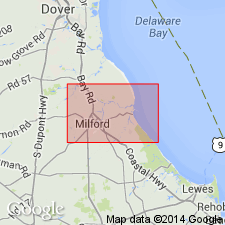
- Usage in publication:
-
- Pensauken
- Modifications:
-
- Not used
- AAPG geologic province:
-
- Atlantic Coast basin
Summary:
Pensauken Formation of NJ, as mapped in DE by Owens and Minard (1979), not used in this report. Author retains Columbia Formation, as used by Jordan (1974).
Source: GNU records (USGS DDS-6; Reston GNULEX).
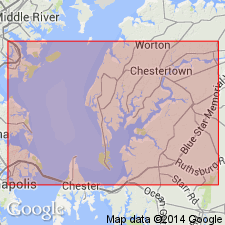
- Usage in publication:
-
- Pensauken Formation
- Modifications:
-
- Overview
- AAPG geologic province:
-
- Atlantic Coast basin
Summary:
Pensauken Formation occupies interval from 18.5 to 0 ft in the Ken-Bf 180 core-hole, overlying 5 ft of strata tentatively assigned to the Old Church Formation. Age given as late Miocene(?) to early Pliocene(?), but without supporting biostratigraphic data.
Source: GNU records (USGS DDS-6; Reston GNULEX).
For more information, please contact Nancy Stamm, Geologic Names Committee Secretary.
Asterisk (*) indicates published by U.S. Geological Survey authors.
"No current usage" (†) implies that a name has been abandoned or has fallen into disuse. Former usage and, if known, replacement name given in parentheses ( ).
Slash (/) indicates name conflicts with nomenclatural guidelines (CSN, 1933; ACSN, 1961, 1970; NACSN, 1983, 2005, 2021). May be explained within brackets ([ ]).

